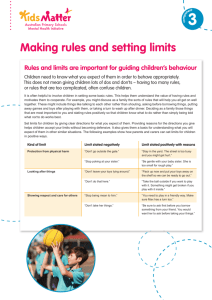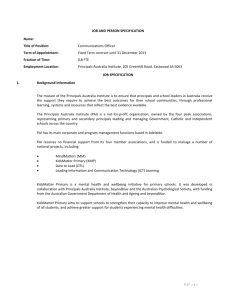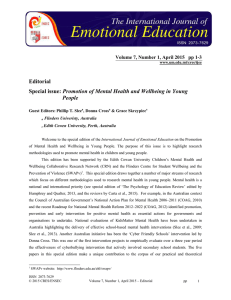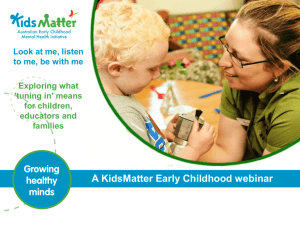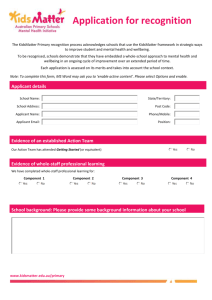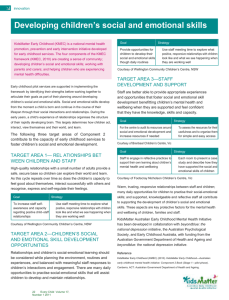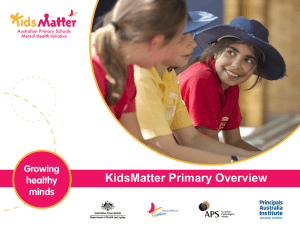Whole-school mental health promotion in Australia Phillip T. Slee
advertisement
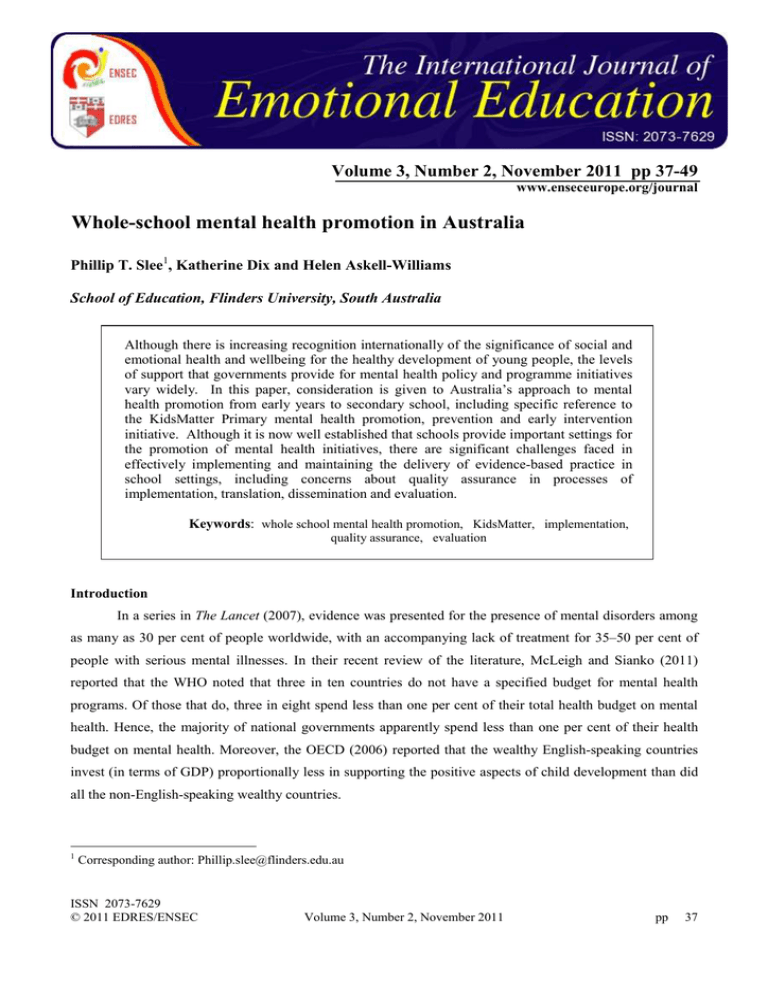
Volume 3, Number 2, November 2011 pp 37-49 www.enseceurope.org/journal Whole-school mental health promotion in Australia Phillip T. Slee1, Katherine Dix and Helen Askell-Williams School of Education, Flinders University, South Australia Although there is increasing recognition internationally of the significance of social and emotional health and wellbeing for the healthy development of young people, the levels of support that governments provide for mental health policy and programme initiatives vary widely. In this paper, consideration is given to Australia’s approach to mental health promotion from early years to secondary school, including specific reference to the KidsMatter Primary mental health promotion, prevention and early intervention initiative. Although it is now well established that schools provide important settings for the promotion of mental health initiatives, there are significant challenges faced in effectively implementing and maintaining the delivery of evidence-based practice in school settings, including concerns about quality assurance in processes of implementation, translation, dissemination and evaluation. Keywords: whole school mental health promotion, KidsMatter, implementation, quality assurance, evaluation Introduction In a series in The Lancet (2007), evidence was presented for the presence of mental disorders among as many as 30 per cent of people worldwide, with an accompanying lack of treatment for 35–50 per cent of people with serious mental illnesses. In their recent review of the literature, McLeigh and Sianko (2011) reported that the WHO noted that three in ten countries do not have a specified budget for mental health programs. Of those that do, three in eight spend less than one per cent of their total health budget on mental health. Hence, the majority of national governments apparently spend less than one per cent of their health budget on mental health. Moreover, the OECD (2006) reported that the wealthy English-speaking countries invest (in terms of GDP) proportionally less in supporting the positive aspects of child development than did all the non-English-speaking wealthy countries. 1 Corresponding author: Phillip.slee@flinders.edu.au ISSN 2073-7629 © 2011 EDRES/ENSEC Volume 3, Number 2, November 2011 pp 37 In the Australian context, mental health has more recently become a national priority, although it has been maturing over the last decade or so with foundational work, such as by Northfield et al. (1997). The Council of Australian Governments' National Action Plan for Mental Health 2006-2011 (DoHA, 2010) identifies the 'promotion, prevention and early intervention' for positive mental health as the first Action Area. There are significant educational, personal, social, occupational and economic costs to individuals and communities associated with mental health difficulties. Mental health disorders are the leading contributor to the total burden of illness among young Australians, with depression, anxiety, and substance use disorders being most common (Sawyer, Miller-Lewis, and Clark, 2007). Importantly, adolescence is often described as the peak time for the onset of mental health problems, with up to 50 per cent of all cases occurring prior to 14 years of age (Kessler et al., 2005). This relatively early onset points to the need for early intervention to prevent difficulties. Early Intervention The science of early intervention has received considerable coverage in recent years. In a review of the field, Gurlink (2008) noted a number of factors underpinning the concept of early intervention, including (i) culture - which is associated with values and attitudes, (ii) political systems -with different governments attaching different significance to the concept, (iii) resources - the investment a country makes in early intervention, and (iv) societal commitment - the priority that a country places on the health and wellbeing of children. As Doyle et al. (2009, p.2) have emphasised, "intervening in the zero-to-three period, when children are at their most receptive stage of development, has the potential to permanently alter their development trajectories and protect them against risk factors present in their early development." Researchers have noted the considerable diversity in opinion that surrounds the concept of early intervention. Medically oriented models of early intervention focus on the remediation of physical conditions impacting on a child's development. More psychologically and/or socially focussed models attend to remediating the child's personal, social or environmental resources (Rowling, 2003). As McCollum (2002, p. 5) has noted, there are also developmentally based models of early intervention "directed towards promoting cognitive or social development by optimising opportunities for learning". Quite apart from the physical, social and psychological arguments in favour of early intervention, Doyle et al. (2009) have identified very strong economic imperatives based on cost-benefit analyses of returns on investments that are made early in children's lives. As Doyle et al. (p.2) noted, "The economic argument for early investment does not preclude later investment: rather it argues that there are dynamic complementarities to be gained from investing at different stages of the life cycle, starting as early as possible The above brief review of the literature suggests that effective intervention in early stages of the development of a mental health difficulty is considered to be a key strategy for achieving successful mental health outcomes (Littlefield, 2008). The imperative for early intervention leads to the recognition that schools ISSN 2073-7629 © 2011 EDRES/ENSEC Volume 3, Number 2, November 2011 pp 38 are ideal entry points for the delivery of universal and preventative services that address children's physical and mental health. Schools as settings for early intervention Murray-Harvey and Slee (2010, p.271) argued that “it is important that schools provide an environment that makes it possible for their students to thrive and to achieve, not only academically but in all ways that relate to their overall well-being”. It is well accepted that education is positively related to health, and that schools play a key role in promoting healthy behaviours and attitudes. However, there is no doubt that improved understanding of the relationship between education and health will help to identify where interventions are most effectively targeted. Schools have ready-made populations of students that can be targeted for general, as well as specific, mental health promotion initiatives (Domitrovich, 2008; WHO, 2011). Mental health promotion initiatives in schools typically revolve around social and emotional learning (SEL). In a large scale meta-analysis of the SEL literature, Durlak et al. (2011) reported that SEL programs were effective in significantly improving social and emotional competencies by reducing conduct disorders and internalizing behaviours, along with increasing pro-social behaviours. Durlak et al. also reported that classroom teachers were effective in conducting the SEL programs as components of routine educational practices. However, the authors cautioned that “developing an evidence-based intervention is an essential but insufficient condition for success; the program must be well executed” (Durlak et al., 2011, p. 418) and we return to this point about quality implementation later in this paper. In addition, there is a growing body of evidence that indicates that school–community partnerships positively influence outcomes for students, showing increases in attendance rates, decreases in cases of recurrent absenteeism, improvements in educational success resilience, behaviour and attitude. It has been proposed that partnerships between school and community are critical in enabling students to achieve the best life outcomes, (e.g. Anderson-Butcher et al., 2006; Mastro, et al., 2006; Cohen, et al., 2007). School– community partnerships are an essential component of the Health Promoting School model (Northfield et al., 1997; Marshall et al., 2000; Rissel and Rowling, 2000; Manchester, 2004). Research from Australia, the United Kingdom and the United States has indicated that these partnerships are particularly advantageous for schools in low socio-economic, socially excluded communities, and assist in addressing social and educational inequalities. Schools alone lack the capacity and resources needed to both educate and counteract the numerous barriers to learning experienced by many socially disadvantaged students. A wealth of literature indicates that partnerships with parents, families and communities can provide needed resources, support and assistance to schools to help address the complexity of student needs (Sanders, 2001; Sanders and Harvey, 2002; Tett et al., 2003; Anderson-Butcher and Ashton, 2004; Martinez et al., 2004; Tett, 2005; Warren, 2005; Cohen et al., 2006; Mastro et al., 2006; Dix et al., 2011). Such partnerships have been shown to be protective for students by promoting positive mental health ISSN 2073-7629 © 2011 EDRES/ENSEC Volume 3, Number 2, November 2011 pp 39 and helping to alleviate environmental learning and social barriers, thereby enhancing academic and social competencies. Addressing Mental Health in Australia One example of an initiative that has grown from a partnership between schools, government and non-government organisations is KidsMatter Primary, which is an Australian national primary school mental health promotion, prevention and early intervention initiative (KidsMatter, 2010). KidsMatter was developed in collaboration with the Australian Government Department of Health and Ageing, beyondblue, the Australian Psychological Society, and Principals Australia, and was supported by the Australian Rotary Health Research Fund. The KidsMatter framework is consistent with the WHO (2011) model that outlines risk and protective factors that reside in the child, family, school, life events and social settings. ‘KidsMatter Primary’ has been developed, trialled and evaluated (Slee et al., 2009) and is currently being rolled out to 2100 primary schools across Australia. Another initiative is ‘KidsMatter Early Childhood, with a focus on the early years, and which is currently undergoing trial and evaluation (KMEC, 2011). A mental health promotion program for the teenage years, ‘MindMatters”, has seen the delivery of curriculum resources and professional development support to Australian secondary schools. Aspects of the MindMatters programme have been evaluated (e.g., AskellWilliams et al., 2005; Hazell, 2005; Rowling and Mason, 2005). As such, as noted earlier in this paper, in Australia the potential is for realizing whole-site mental health promotion from birth to adolescence. Figure 1 provides an overview of the scope and sequence of these government supported school-based mental health promotion initiatives in Australian schools. In the present paper, a focus is on the recently developed and evaluated KidsMatter Primary initiative (Slee et al., 2009). KidsMatter Primary uses a whole-school approach. It provides schools with a framework, an implementation process, and key resources to develop and implement evidence-based mental health promotion, prevention and early intervention strategies. The KidsMatter framework consists of four key areas, designated as the KidsMatter components: 1. Positive school community; 2. Social and emotional learning for students; 3. Parenting support and education; 4. Early intervention for students experiencing mental health difficulties. The positive school community component encourages schools to engender a sense of belonging and inclusion in members of their communities, by providing a welcoming and friendly school environment, and a collaborative sense of involvement of students, staff, families and the local community. The SEL component is designed to help schools select and enact a clearly structured social and emotional learning curriculum for all students covering the five core social and emotional competencies as identified by the Collaborative for ISSN 2073-7629 © 2011 EDRES/ENSEC Volume 3, Number 2, November 2011 pp 40 Figure 1: The Suite of mental health promotion initiatives in Australia (source: Dix, 2011) infancy Early childhood middle childhood adolescence Academic, Social and Emotional Learning (CASEL, 2006): self-awareness, social awareness, selfmanagement, relationship skills, and responsible decision making. The parenting component focuses on the school as an access point for families to learn about parenting, child development and children’s mental health in order to assist parents with their child rearing and parenting skills. The final component comprising early intervention is designed to assist schools to support children showing early signs of mental health difficulties, as well as those children identified as having ongoing mental health problems. KidsMatter aims to improve the mental health and well-being of primary school students, reduce mental health difficulties amongst students, and achieve greater support for students experiencing mental health difficulties (KidsMatter, 2010). The KidsMatter trial phase was carried out in 2007 to 2009 in 100 primary schools across Australia, with the school sample including different States, systems and rural/urban schools. The evaluation of the trial showed that it was associated with changes to schools' cultures and ISSN 2073-7629 © 2011 EDRES/ENSEC Volume 3, Number 2, November 2011 pp 41 approaches to mental health difficulties, as well as changes that served to strengthen protective factors within the school, families and children (Slee et al., 2009). Importantly, KidsMatter was associated with improvements in students' measured mental health, especially for students with higher pre-intervention levels of mental health difficulties. These findings helped to inform policy decisions for ongoing Federal Government funding for the roll-out of KidsMatter to 2100 Australian schools by 2014, and the initiation of the KidsMatter Early Childhood trial initiative that is currently running in early childhood centres. In order to convince stakeholders that health promotion initiatives are worthwhile investments, there is a need for strong evidence that the initiatives do make a difference to school environments and student wellbeing. Evidence from outcome evaluations is growing. The above-mentioned recent review by Durlak et al. (2011) indicated that rigorous assessments of outcomes of mental health promotion initiatives in schools demonstrate that such programs can have an impact upon students' social and emotional skills and academic performance, which are recognised mediators to positive mental health. Yet the existence of such evidence does not guarantee that, in general, schools know about, or use, that evidence to shape their curriculum offerings. Translation and Dissemination Following from the trial phases of projects, such as the 2007 to 2009 phase of KidsMatter described above, there is a growing body of research concerned with identifying features that support translation and dissemination of effective programs from small-scale efficacy trials into the broader contexts of real-world settings. As Durlak et al. (2011) have noted, interventions are unlikely to have much practical utility or gain widespread acceptance unless they are effective under real-world conditions: Can, for example, SEL programs, be incorporated into routine educational practice and be successfully delivered by existing school staff during the regular school day? Recently, Resnick (2010) drew attention to how the structural affordances and constraints of educational organisations facilitate the successes or failures of educational initiatives. Even within a cluster of settings that may be structurally similar (such as schools within similar locations within the same educational system), conditions that influence operations can vary widely. For example, Askell-Williams, Lawson and Slee (2009) discussed a range of personal and social conditions, such as students' and teachers' background knowledge, existing SEL programs, availability of resources, and leadership commitment to the aims of the initiatives, that vary across schools and can influence implementation of new initiatives. Similarly, Lee et al. (2008) and Humphrey, Lendrum and Wigglesworth (2010) argued that, in complex settings such as schools, different personnel with different levels of pedagogical expertise might be given responsibility for delivering programs, key program components might be modified or deleted, and inconsistencies in program delivery could develop. Other Australian research (Slee and Murray-Harvey, 2007) has identified the significant role that social factors such as poverty, geographic location and the availability of community support agencies ISSN 2073-7629 © 2011 EDRES/ENSEC Volume 3, Number 2, November 2011 pp 42 play in ameliorating mental health problems. These conditions would be expected to influence the translation and dissemination of mental health promotion initiatives. For health promotion sites like schools, becoming involved in new health promotion initiatives requires allocation of substantial resources, such as providing professional development, paying for teacher release time, developing curriculum resources, and working with students in new ways. There are costs associated with the work required to sustain, translate and disseminate viable initiatives. However, if such work is not done, the demonstrated value of the program will not be realised and newly developed knowledge, capabilities and practices will be lost. Funding bodies, organisations, staff, community stakeholders, and students, lose what they have invested, financially and emotionally, when a viable program is not sustained (Shediac-Rizkallah and Bone, 1998; Pluye et al, 2004). However, the transition between a positive evaluation of a trial of a new program, and implementing and sustaining the program in authentic settings over longer terms, can be difficult to manage. As such, a key issue of concern, for current and future school-based mental health promotion, is the spread and sustainability of initiatives such as KidsMatter beyond the relatively highly resourced trial phase. One common translational framework is the five-phase model initially put forward by Greenwald and Cullen (1985), and more recently discussed by Reynolds and Spruijt-Metz (2006). In this model, the five phases include (a) basic research, (b) methods development, (c) efficacy trials, (d) effectiveness trials, and (e) dissemination trials. On the basis of a review of the literature, Slee et al. (2011) have proposed a seven step model comprising (i) promotion (ii) readiness (iii) adoption (iv) implementation (v) sustainability, (vi) monitoring and (vii) incentive (see Figure 2). Figure 2: Phases of new initiatives (source: Dix and Murray-Harvey, 2011) As displayed in Figure 2, in disseminating an initiative into new school contexts, a number of phases are identifiable. There should be initially some promotion of the initiative to alert school personnel to its availability, followed by some assessment by the school as to its readiness to take on the initiative. In preparing to adopt the initiative, a whole-school decision is required in order to engage all stakeholders. The ISSN 2073-7629 © 2011 EDRES/ENSEC Volume 3, Number 2, November 2011 pp 43 implementation phase must consider how well each component of the initiative relates to the specific needs of the local community, and at this stage there is a clear need to attend to issues of translation form trial to realworld contexts. A significant element in translating the initiative into a school setting, concerns attending to matters of fidelity, dosage and quality of delivery (Domitrovich et al., 2008). Ongoing monitoring of the initiative is required and finally consideration is needed of the incentives or recognition given to schools and/or individuals for taking on the initiative. In Step 6, Figure 2 underlines that monitoring of the processes of implementation is essential. The high quality implementation of wellbeing initiatives is vital to achieving their designated outcomes (Mukoma and Flisher, 2004; Domitrovich et al., 2008). Quality assurance of evaluations A related quality assurance issue concerns the need to develop evaluation standards that are capable of making claims about programs that are viable and reliable for counting towards 'evidence-based’ practice (Schwandt, 1990). As the field of evaluation has matured and developed, the call for quality assurance has grown stronger. The development of evaluation standards is one part of a move toward "evidence-based‟ practice. The focus on quality is also evident in attempts to define, describe, and improve meta-evaluation. Overall, improving, ensuring, and monitoring evaluation quality are significant concerns (Schwandt, 1990). This same author identifies three approaches to quality assurance, namely a "product-based‟ focus, which urges consideration of the objective characteristics or features of evaluation products, "manufacturingbased‟ views that emphasize conformance to requirements, and "user-based‟ definitions that stress the importance of designing and delivering services that fit client needs. Each of the three approaches has advantages and disadvantages and ultimately, and as Schwandt, (p. 187) noted, “At the strategic level, quality has to do with articulating a vision for clients of what the profession promotes as quality service.” Other literature indicates that defining the term "quality assurance‟ is not a straightforward matter (Cuttance, 1995; Herselman and Hay, 2002; Sallis, 2002). Cuttance drew a useful distinction between ‘quality control’, ‘quality assurance’ and ‘quality management. Cuttance defined 'quality control' as a means of comparing output with defined standards such as standardised testing. 'Quality assurance' seeks to prevent issues before they arise and is concerned with processes rather than outcomes, processes which address the need for accountability and quality improvement. 'Quality management' complements quality assurance through a continuous review of the needs of a school's clients, however defined, and a continuing ability to meet them. An integrative management approach is required to build an ethos of continuous review and improvement of all aspects of a school's work. Murgatroyd and Morgan (1993, p.45) defined quality assurance as “the determination of standards, appropriate methods and quality requirements by an expert body, accompanied by a process of inspection or evaluation that examines the extent to which practice meets the standards”. Their definition captures significant elements pertinent to the current paper. ISSN 2073-7629 © 2011 EDRES/ENSEC Volume 3, Number 2, November 2011 pp 44 While there is a need to consider quality control and quality management, quality assurance, with its focus on process, is beginning to be seen as a necessary component of interventions. In particular, the intention of quality assurance is to monitor and assess the practice and process of program implementation in order to ensure that the effective standards of the program are being maintained. In particular, Domitrovich and Greenberg (2000) have raised concerns regarding the lack of studies reporting the relationship between the quality of implementation of mental health promotion initiatives and desired outcomes, such as improved student SEL. An approach to quality assurance used in the evaluation of the KidsMatter primary initiative was developed by Slee et al. (2009), who developed an Implementation Index designed to measure implementation quality. The Implementation Index contained categories of schoolbased actions that identified more- and less-successful components of implementation. In response to concerns such as those raised by Domitrovich and Greenberg (2000) about relationships between implementation and outcomes, Slee and colleagues’ (2009) application of the Implementation Index was further extended to demonstrate that a significant positive relationship existed between quality of implementation of the KidsMatter initiative and the academic performance of primary school students (Dix et al., 2011). After controlling for differences in socioeconomic background, Dix et al. found that the difference in academic performance between students in high- and low-implementing KidsMatter schools, as assessed by the Implementation Index, was equivalent to up to six months of schooling. Further research is warranted to tease apart the relationship between the quality of implementation and outcomes such as academic achievement. As Dix et al. (2011) have cautioned, schools that implement initiatives such as KidsMatter well, also probably attend to other aspects of student’s schooling well, including attention to the learning environment and the support they provide students, better enabling them to achieve academically. Conclusion “If we keep on doing what we have been doing, we will keep on getting what we have been getting” (Wandersman et al., 2008, p.171). The gap between research and practice has been a longstanding concern. The increasing demand for evidence-based practice means an increasing need for more practice-based evidence. As Durlak and DuPre (2008, p. 327) noted: “Social scientists recognise that developing effective interventions is only the first step toward improving the health and well-being of populations. Transferring effective programs into real world settings and maintaining them there, is a complicated, long-term process that requires dealing effectively with the successive, complex phases of program diffusion.” This paper has broadly outlined an international perspective on mental health based on a platform of early intervention. It has been argued that schools are appropriate sites for trial, implementation, translation and dissemination of mental health programmes, and that there is an emerging body of evidence to suggest that teachers can effectively deliver mental health programs in the context of the school curriculum. It has described an Australian primary school mental health initiative (KidsMatter) that has been evaluated and ISSN 2073-7629 © 2011 EDRES/ENSEC Volume 3, Number 2, November 2011 pp 45 found to have positive impacts upon student mental health. The matter of how programs translate to the everyday worlds of schools is considered, and a dissemination model is described. The effective navigation of the complex tasks needed for implementing quality assurance requires cycles of ongoing, systematic evaluative research that is responsive to many competing needs. References ALTC. (2011). Dissemination: Retrieved June 26th, 2011 from http://www.altc.edu.au/dissemination. Askell-Williams, H., Lawson, M. J., and Murray-Harvey, R. (2005). Teaching and learning about mental illnesses: an Australian perspective. International Journal of Mental Health Promotion, 9(4), 26-36. Askell-Williams, H., Lawson, M. J., and Slee, P. T. (2009). Venturing into schools: Locating mental health initiatives in complex environments. The International Journal of Emotional Education, 1(2), 14-33. CASEL. (2006). What is social and emotional Learning: Skills and competencies. Retrieved 4th Aug 2008, from http://www.casel.org/basics/skills.php Cuttance, P. (1995) Quality Assurance and Quality Management in Education Systems, in C. Evers, and J. Chapman, (Eds) Educational Administration: An Australian Perspective (pp. 296-316). St Leonards: Allen and Unwin. Dix, K.L. (2011). Connecting quality mental health implementation with student academic performance. Keynote Address at Celebrating Mental Health in Schools, Mental Health Week, 12 October 2011, Hobart, Australia. Dix, K.L. and Murray-Harvey, R. (2011). Teacher professional learning: Towards a shared understanding about student mental health. In R. Shute, P.T. Slee, R.Murray-Harvey, and K.L. Dix (Eds.) Mental health and wellbeing: Educational perspectives (pp.143-155). Adelaide: Shannon Research Press. Dix, K.L., Keeves, J.P., Slee, P.T., Lawson, M.J., Russell, A., Askell-Williams, H., Owens, L., Skrzypiec, G. and Spears, B. (2010). The KidsMatter Evaluation: Technical Report and User Guide. Centre for Analysis of Educational Futures. Flinders University. Adelaide: Shannon Research Press. Dix, K.L., Shearer, J., Slee, P.T. and Butcher, C. (2010). KidsMatter for Students with a Disability: Evaluation Report. Ministerial Advisory Committee: Students with Disabilities, Adelaide, Australia. Dix, K.L., Slee, P.T., Lawson, M.J. and Keeves, J.P. (2011). Implementation quality of whole-school mental health promotion and students’ academic performance. Child and Adolescent Mental Health (in press). DoHA. (2010). COAG National Action Plan on Mental Health (2006-2011) [ElectronicVersion] from http://www.health.gov.au/coagmentalhealth. Domitrovich, C. E. (2008). Maximizing the implementation quality of evidence-based preventive interventions in schools. A conceptual framework. Advances in School Mental Health Promotion, 1, 6-28. ISSN 2073-7629 © 2011 EDRES/ENSEC Volume 3, Number 2, November 2011 pp 46 Domitrovich, C. E., Bradshaw, C. P., Poduska, J. M., Hoagwood, K., Buckley, J. A., Olin, S., et al. (2008). Maximizing the implementation quality of evidence-based preventive interventions in schools. A conceptual framework. Advances in School Mental Health Promotion, 1(3), 6-28. Domitrovich, C. E., and Greenberg, M. T. (2000). The study of implementation: current findings from effective programs that prevent mental disorders in school-aged children. Journal of Educational and Psychological Consultation, 11, 193–221. Doyle,D., Colm P., Harmon, C.P., Heckmanc, J.J., and Tremblay, R.E. (2009). Investing in early human development: Timing and economic efficiency. Econ Human Biology, 7(1): 1–6. Durlak, J. A., and DuPre, E. P. (2008). Implementation matters: a review of research on the influence of implementation on program outcomes and factors affecting implementation. American Journal of Community Psychology, 41, 327-350. Durlak, J. A., Weissberg, R. P., Dymnicki, A. B., Taylor, R. D., and Schellinger, K. B. (2011). The impact of enhancing students' social and emotional learning: A meta-analysis of school-based universal interventions. Child Development, 82, 405-432. Greenwald, P., and Cullen, J. (1985). The new emphasis in cancer control. Journal of the National Cancer Institute, 74, 543-551. Guralnick, M.J. (2008)International perspectives on Early Intervention: A search for common ground. Journal Early Intervention, 30, 90-101. Hazell, T. (2005). MindMatters: Evaluation of the Professional Development Program and School-level Implementation. Sydney: Hunter Institute of Mental Health. Herselman, M. and Hay, D. (2002). Quality assurance in the foundation phase in the eastern cape province: a case study. South African Journal of Education, 22(3), 239 – 245. Humphrey, N., Afroditi Kalambouka, A., Wigelsworth, M. and Lendrum, A. (2010). Going for goals: an evaluation of a short, social-emotional intervention for primary school children. School Psychology International, 31: 250. Kessler, R.C., Berglund, P., Demler, O., Jin, R., Merikangal, K., and Walters, E (2005). Lifetime prevalence \ and age-on-set distribution of DSM-IV disorder in the national comorbidity survey replication. Archives general psychiatry, 62, 593-603. KidsMatter. (2010). KidsMatter Primary Framework. Retrieved June 25th 2011 from http://www.kidsmatter.edu.au/kidsmatter-overview/framework/ KMEC. (2011). KidsMatter Australian Early Childhood Mental Health Initiative. Retrieved 1st Feb 2011, from http://www.kidsmatter.edu.au/ec/ Lancet Global Mental Health Group. (2007). The Lancet series on global mental health. Retrieved 1st February 2011 from: http://www.thelancet. com/series/global-mental-health. Lee, C., August, G. J., Realmuto, G. M., Horowitz, J. L., Bloomquist., M. L., and Klimes-Dougan., B. (2008). ISSN 2073-7629 © 2011 EDRES/ENSEC Volume 3, Number 2, November 2011 pp 47 Fidelity at a distance: Assessing implementation fidelity of the early–risers prevention program in going-to-scale intervention trial Prevention Science, 9, 215-229. Littlefield, L. (2008). Towards a comprehensive national early intervention program for children with mental health problems. Australian e-Journal for the Advancement of Mental Health 7(1). McCollum, J.A. (2002). Influencing the development of young children with disabilities: current themes in early intervention. Child and Adolescent Mental Health 7, (1), 4-9. McLeigh , J.D. and Sianko N. (2011) What should be done to promote mental health around the world? American Journal of Orthopsychiatry, 81 (1), 83–89. Mukoma, W. and Flisher, A. J. (2004). Evaluations of health promoting schools: a review of nine studies. Health Promotion International, 19(3), 357-368. Murgatroyd, S. and Morgan, C. (1993). Total quality management and the school. Philadelphia: Open University Press. Murray-Harvey, R. and Slee, P.T. (2010). School and home relationships and their impact on school bullying. School Psychology International, 31 (3), 271-295. Northfield, J., St Leger, L. H., Sheehan, M., Marshall, B., Maher, S. and Carlisle, R. (1997). School-Based Health Promotion Across Australia. Sydney: Australian Health Promoting Schools Association (AHPSA). OECD (2006). Starting strong II: Early Childhood Education and Care. Paris: OECD Publications. Pluye, P., Potvin, L., Denis, J. L., and Pelletier, J. (2004). Program sustainability: focus on organisational routines. Health Promotion International, 19, 489-500. Resnick, L. B. (2010). Nested learning systems for the thinking curriculum. Educational Researcher, 39, 183. DOI: 10.3102/0013189X10364671. Reynolds, K.D., and Spruijt-Metz. D. (2006). Translational research in childhood obesity prevention. Evaluation and the Health Professions, 29, 219–245. Rowling, L. (2003). School mental health promotion -theoretical, conceptual and practical issues. Australian Journal of Guidance and Counselling, 13, 11–21. Rowling, L, and Mason, J. (2005). A case study of multimethod evaluation of complex school mental health promotion and prevention: The MindMatters Evaluation Suite. Australian Journal of Guidance and Counselling, 15(2), 125–136. Sallis, E. (1993). Total quality management in education. Philadelphia; London: Kogan Page. Sawyer, M.G., Miller-Lewis, L.R., and Clark, J.J. (2007). The mental health of 13–17 year-olds in Australia: Findings from the national survey of mental health and well-being. Journal of Youth and Adolescence, 36, 185–194. Schwandt, T. (1990). Paths to enquiry in the social disciplines. In E. Guba (Ed.), The Paradigm Dialog. Newbury Park: Sage. ISSN 2073-7629 © 2011 EDRES/ENSEC Volume 3, Number 2, November 2011 pp 48 Shediac-Rizkallah, M. C. and Bone, L. R. (1998). Planning for the sustainability of community-based health programs: conceptual frameworks and future directions for research, practice, policy. Health Education Research: Theory and Practice, 13, 87-108. Slee, P. (2006). Families at Risk: The effects of chronic and multiple disadvantage. Adelaide: Shannon Research Press. Slee, P.T., Lawson, M.J., Russell, A., Askell-William, H., Dix, K.L., Owens, L., Skrzypiec, G. and Spears, B. (2009). The KidsMatter evaluation: Final report. Centre for Analysis of Educational Futures, Flinders University, Adelaide. Slee, P.T. and Murray-Harvey, R. (2007). Disadvantaged children’s physical, developmental and behavioural health problems in an urban environment. Journal of Social Services Research, 33, 57-69. Wandersman, A., Duffy, J., Flaspohler, P., Noonan, R., Lubell, K., Stillman, L., Blachman, M.,Dunville, R., and Saul, J. (2008). Bridging the gap between prevention research and practice: The interactive systems framework for dissemination and implementation. American Journal of Community Psychology, 41:171–181. WHO. (2011). Mental health: strengthening mental health promotion. Retrieved 1st Feb 2011, from http://www.who.int/mediacentre/factsheets/fs220/en/ ISSN 2073-7629 © 2011 EDRES/ENSEC Volume 3, Number 2, November 2011 pp 49
